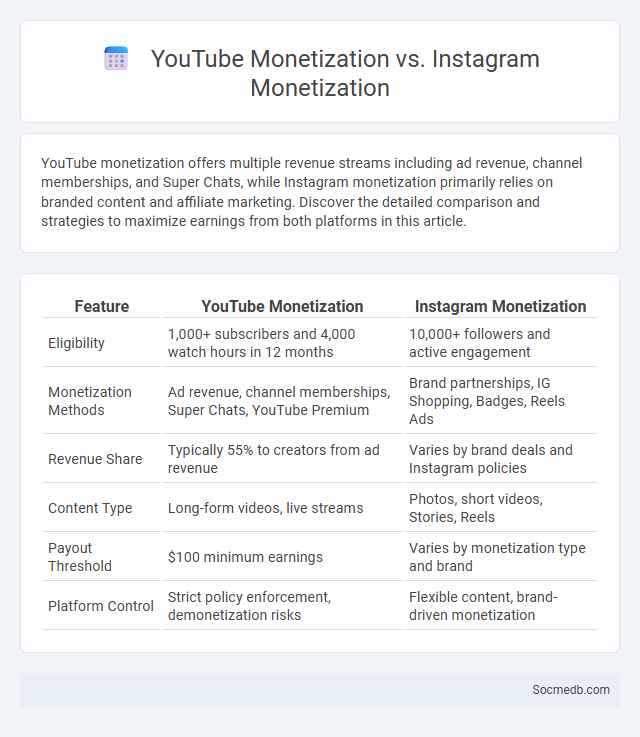
Photo illustration: YouTube Monetization vs Instagram Monetization
YouTube monetization offers multiple revenue streams including ad revenue, channel memberships, and Super Chats, while Instagram monetization primarily relies on branded content and affiliate marketing. Discover the detailed comparison and strategies to maximize earnings from both platforms in this article.
Table of Comparison
| Feature | YouTube Monetization | Instagram Monetization |
|---|---|---|
| Eligibility | 1,000+ subscribers and 4,000 watch hours in 12 months | 10,000+ followers and active engagement |
| Monetization Methods | Ad revenue, channel memberships, Super Chats, YouTube Premium | Brand partnerships, IG Shopping, Badges, Reels Ads |
| Revenue Share | Typically 55% to creators from ad revenue | Varies by brand deals and Instagram policies |
| Content Type | Long-form videos, live streams | Photos, short videos, Stories, Reels |
| Payout Threshold | $100 minimum earnings | Varies by monetization type and brand |
| Platform Control | Strict policy enforcement, demonetization risks | Flexible content, brand-driven monetization |
Introduction to Social Media Monetization
Social media monetization involves leveraging platforms like Instagram, YouTube, and TikTok to generate revenue through ads, sponsorships, and affiliate marketing. Influencers and content creators maximize earnings by building targeted audiences and utilizing analytics to optimize engagement and conversion rates. Effective monetization strategies depend on diverse income streams including branded content, merchandise sales, and subscription models.
Understanding YouTube Monetization Methods
YouTube monetization methods include ad revenue, channel memberships, Super Chat, and merchandise shelf integration, each offering unique ways to generate income from your content. Understanding the YouTube Partner Program requirements, such as 1,000 subscribers and 4,000 watch hours, is essential to unlock ad revenue opportunities. Your ability to diversify monetization strategies will enhance your earning potential and maximize your channel's financial growth.
How Instagram Monetization Works
Instagram monetization primarily works through features like sponsored posts, affiliate marketing, and in-app shopping, allowing creators to earn revenue by promoting products or services. Instagram's partner programs, such as Instagram Live Badges and Reels Play Bonus, offer direct payment based on viewer engagement and content performance. Brands collaborate with influencers using data-driven insights to target audiences effectively, maximizing ROI through personalized marketing campaigns on the platform.
Exploring Ad Revenue Streams
Exploring ad revenue streams on social media involves leveraging platforms such as Facebook, Instagram, YouTube, and TikTok to monetize content through targeted advertisements, sponsored posts, and affiliate marketing. Your ability to analyze audience demographics and engagement metrics enhances the potential to optimize ad placements and increase click-through rates. Maximizing these revenue streams requires continuous adaptation to algorithm changes and emerging advertising formats to sustain profitability.
YouTube vs Instagram: Monetization Eligibility
YouTube requires creators to have at least 1,000 subscribers and 4,000 watch hours in the past 12 months to join the YouTube Partner Program and access monetization features such as ad revenue, memberships, and Super Chat. Instagram monetization eligibility often depends on meeting criteria like 10,000 followers or 30,000 views in the last month for features such as Affiliate Shops, Badges, and IGTV ads. Both platforms emphasize consistent content creation and engagement but differ significantly in audience size thresholds and monetization methods.
Comparing Revenue Potential on YouTube and Instagram
YouTube generates higher revenue potential through its comprehensive monetization options like AdSense, Super Chats, and Channel Memberships, attracting content creators aiming for substantial income. Instagram, while strong in influencer marketing and sponsored posts, typically offers more limited direct earnings compared to YouTube's multifaceted approach. Brands prioritize YouTube for long-form content engagement and broader audience reach, leveraging higher advertising rates and better revenue shares.
Ad Revenue: Platform Differences and Earnings
Social media platforms generate significant ad revenue, with Facebook leading due to its massive user base and sophisticated targeting algorithms, followed closely by YouTube and Instagram. TikTok's rapid growth has also driven impressive ad earnings through innovative video-based ad formats and high engagement rates. Differences in platform monetization strategies and audience demographics directly impact advertisers' ROI and overall revenue distribution in the digital advertising landscape.
Algorithm Influence on Monetization Success
Social media algorithms prioritize content based on user engagement metrics, directly impacting monetization success by amplifying visibility for creators and brands. The algorithm's ability to target niche audiences increases ad relevance, leading to higher click-through rates and revenue generation. Optimizing content for these algorithms is essential for maximizing monetization opportunities on platforms like Instagram, TikTok, and YouTube.
Creator Tools and Analytics: YouTube vs Instagram
YouTube Creator Tools offer comprehensive video editing, audience engagement features, and monetization options that empower your content creation and growth. Instagram provides intuitive editing tools combined with in-depth analytics for stories, reels, and posts, helping you understand audience behavior and optimize engagement. Comparing analytics, YouTube's detailed data on watch time, demographics, and revenue outperform Instagram's focus on impressions, reach, and engagement metrics for creators aiming to maximize impact.
Choosing the Right Platform for Monetization
Choosing the right social media platform for monetization depends on your target audience, content type, and engagement style. Platforms like Instagram and TikTok excel for visual and short-video content, while YouTube is ideal for long-form videos and monetization through ads and memberships. Understanding where your audience spends the most time allows you to maximize your earnings and grow your brand efficiently.
 socmedb.com
socmedb.com